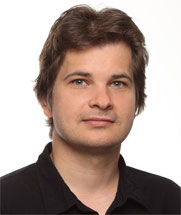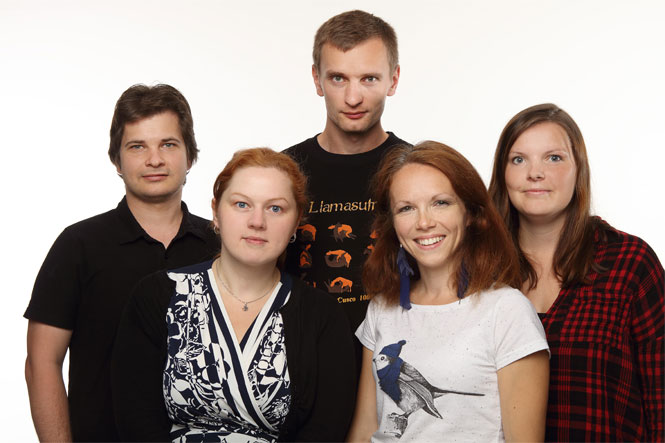
| Ondřej Štěpánek, M.Sc., PhD. | |
| Address: | Institute of Molecular Genetics of the ASCR, v. v. i. Vídeňská 1083 142 20 Prague 4, Czech Republic |
| Phone: | |
| Fax: | |
| E-mail: | ondrej.stepanek@img.cas.cz |
| Name: | Ondřej Štěpánek |
| Nationality: | Czech |
| E-mail: | ondrej.stepanek@img.cas.cz |
| 2007-2011 | Faculty of Science, Charles University Prague, Czech Republic Immunology, degree: PhD. (no grading or distinctions applicable) |
| 2002-2007 | Faculty of Science, Charles University Prague, Czech Republic Biology, Molecular Biology, Mgr. (eq. MA), Summa Cum Laude (highest honors, top 2%) |
| 2002-2005 | Faculty of International Relations, University of Economics Prague, Czech Republic International Economic Relations, Bc. (eq. BA), Summa Cum laude (highest honors) |
| 2016-present | Head, Laboratory of Adaptive Immunity Institute of Molecular Genetics, Czech Academy of Sciences, Prague, Czech Rep. |
| 2012-2016 | Postdoc, Transplantation Immunology and Nephrology, Advisor: Prof. Ed Palmer Department of Biomedicine, University of Basel & University Hospital Basel, Switzerland |
| 2011-2012 | Postdoc, Department of Molecular Immunology, Advisor: Prof. Václav Hořejší Institute of Molecular Genetics, Czech Academy of Sciences, Prague, Czech Rep. |
| 2007-2011 | PhD student, Department of Molecular Immunology, Supervisor: Dr. Tomáš Brdička Institute of Molecular Genetics, Czech Academy of Sciences, Prague, Czech Rep. |
| 2004-2007 | MA student, Yeast Colony Group, Supervisor: Prof. Zdena Palková Faculty of Science, Charles University, Prague, Czech Rep. |
| 2007-2012 | Molecular and Cell Biology for Biophysicists (contribution: 100%) MA level, Faculty of Mathematics and Physics, Charles University, Prague |
| 2007-2012 | Molecular and Cell Biology Methods (contribution: 15%) BA/MA level, Faculty of Science, Charles University, Prague |
| 2011 | Theory of Methods in Immunology (contribution: 15%) MA level, Faculty of Science, Charles University, Prague |
| 2005-2006 | Seminar of Cell Biology (contribution: 100%) Johannes Kepler Grammar School, Prague, Czech Republic |
| 2016 | Forschungsfonds Nachwusforschende, University of Basel, Switzerland |
| 2016-2018 | Czech Science Agency (GAČR): Junior Grant |
| 2016-2018 | (ev. to 2020) EMBO Installation Grant |
| 2016 | Small Grant by EMBO Council |
| 2016-2021 | PROMYS Grant by Swiss National Science Foundation |
|
Adaptive immunity, lymphocyte development, immunological tolerance, T cell receptor signaling, T cell fate decisions, autoimmunity, immune regulations, T cell homeostasis, cytotoxic T cells, regulatory T cells
Our research focuses on understanding of how antigenic signals determine fate decisions of T cells during their development, homeostasis, and immune responses. We cover a wide range of processes, from molecular determinants of T cell responses to cellular interactions in animal models of infection and autoimmunity. At the moment, we are working on three specific projects in the field of regulatory T cells, formation of self-tolerant and immune-sufficient T cell repertoire, and origin and function of ‘virtual’ memory T cells. The long-term aim of our lab is to understand how T cell receptor signals are initiated and how the primary sequence of TCR-encoding genes predetermines various T cell fate decisions during a life-time of an individual.
1. Hyperactivity of self-reactive CD8+ T cells and impaired immune suppression by regulatory T cells (Tregs) are believed to be associated with the development of certain autoimmune disorders, like type I diabetes or multiple sclerosis. We would like to elucidate whether there is a link between these two phenomena, i.e whether regulatory T cells prevent autoimmunity by suppressing self-reactive CD8+ T cells.
For this project, we use an animal model of experimental type I diabetes, based on adoptive transfer of ovalbumin-reactive monoclonal CD8+ OT-I T cells into a transgenic RIP.OVA host expressing ovalbumin in insulin-secreting cells. After being primed with ovalbumin or related antigen, OT-I eventually differentiate into tissue infiltrating effector T cells and induce lethal autoimmunity. By comparing Treg-replete or -depleted hosts, we investigate whether Tregs establish peripheral tolerance by increasing the self-antigen dose, the self-antigen affinity, and/or the number of precursor self-reactive cells required for the onset of autoimmunity. Moreover, we elucidate how conventional CD4+ T cells influence the activation and effector function of self-reactive CD8+ T cells. In the next step, we are going to uncover suppressive mechanisms (e.g. IL-2 stealing, direct killing, inhibiting costimulation) that Tregs use to prevent CD8+ T cell-mediated cytotoxicity.
2. We have previously shown that the interaction between a kinase, Lck and CD4 or CD8 T-cell coreceptors plays a crucial role for setting the threshold for negative selection of thymocytes and establishing the central immunological tolerance. Now, we are investigating the importance of the stoichiometry of the Lck-CD4 and Lck-CD8 for fate decisions made by mature T cells. Our preliminary data indicate that the Lck-CD4 and Lck-CD8 coupling frequency is dynamically regulated during T cell development. Our mathematical model predicts that CD8+ T cells, but not CD4+ T cells, increase their responsiveness to antigens at or just below the affinity threshold for negative selection. We hypothesize that the evolution tuned the stoichiometry of the Lck-CD4 and Lck-CD8 interaction to achieve optimal balance between self-tolerance and efficient responses to tumors and pathogens independently for CD8+ cytotoxic and CD4+ helper T cells. We are now addressing these predictions experimentally using various approaches focused on T cell activation and signal transduction, T cell homeostasis, autoimmunity, anti-tumor and anti-bacterial response.
3. Recent studies have revealed that T cell homeostasis plays an important role in immune responses towards self- and foreign-antigens. However, the mechanisms underlying T cell homeostasis and subsequent immune responses are incompletely understood.
So far enigmatic ‘virtual’ memory CD8+ T cells show memory-like phenotype, but they are generated via an unknown homeostatic process and thus, do not represent true immunological memory. Other studies have shown that self-reactivity of T cells largely determines how particular clones respond during immune responses against invading pathogens.
Based on our preliminary data, we hypothesize that the ‘virtual’ memory T cells originate from naïve peripheral T cells with relatively high self-reactivity. We are now addressing this hypothesis using a panel of approaches involving in vitro and in vivo activation of transgenic monoclonal T cells, in vivo models of autoimmunity and infection, global gene expression profiling and deep TCR sequencing. We also aim to elucidate whether ‘virtual’ memory T cells exist in humans.

Head (IMG fellow)
Ondřej Štěpánek
Project leaders
Peter Dráber
Martina Huranová
Scientists
Aleš Drobek
Klára Ruppová
Technician
Ladislav Cupák
PhD students
Helena Dráberová
Veronika Horková
Alena Moudrá
Daniela Polatová
Oksana Tsyklauri
Undergraduate students
Tereza Chadimová
Veronika Niederlová
Michaela Přibíková
Šárka Janušová
Former lab members
Monika Lakatošová